It’s very pleasing to see the first hatch of the Iron Blue Dun (Baetis Muticis) on UK rivers because it signals that spring is beginning to warm up and the onset of some…
“exciting dry fly fishing for trout”
More importantly, brown trout find them an irresistible meal on the Welsh Dee and River Ribble. As such, I have caught loads of trout using these fly patterns. Thus it’s…
“very important to have fly & nymph imitations in your fly box”
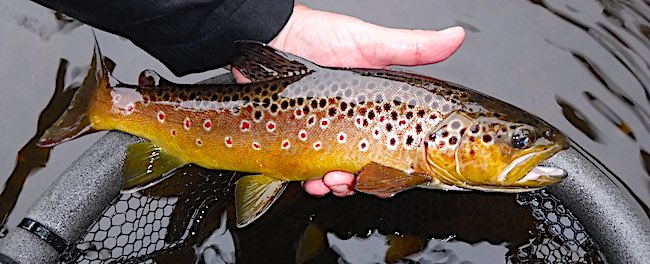
The Iron Blue dun is widespread on many UK rivers, hatching from April to October. Peak hatches usually occur from May to the end of June.
In addition to brown trout, I’ve caught lots of grayling using iron blue fly patterns during the summer months and early into autumn.
Throughout the following sections, I will share flies to imitate the various stages of the life cycle of the Iron Blue Dun.
The Iron Blue Nymph
The Iron Blue fly emerges from a slender agile-darting nymph that spends most of its life in the riffle sections of rivers and streams. Often found in weedy areas and between pebbles and gravel.
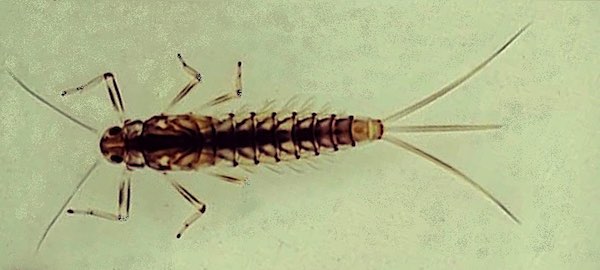
Great flies to use to imitate the nymph include the Pheasant Tail nymph and Iron blue nymph for euro nymphing:
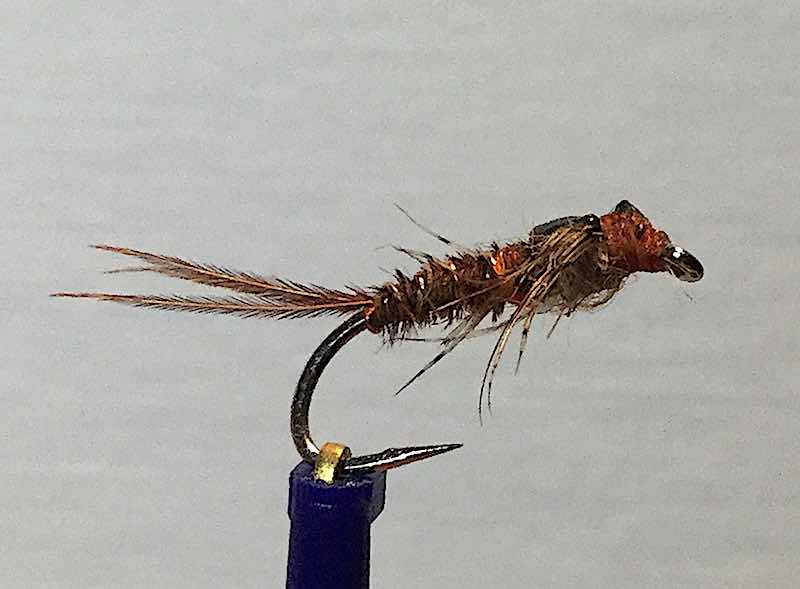
Pheasant Tail nymph
- Kamasan B175 (#14 & #16)
- Orange UNI-thread 8/0
- Tail – 3 pheasant tail fibres tips
- Body – pheasant tail fibres
- Rib – fine copper wire
- Thorax – Hare’s Ear dubbing
- Legs – brown partridge neck tip
- Wing case – natural nymph skin
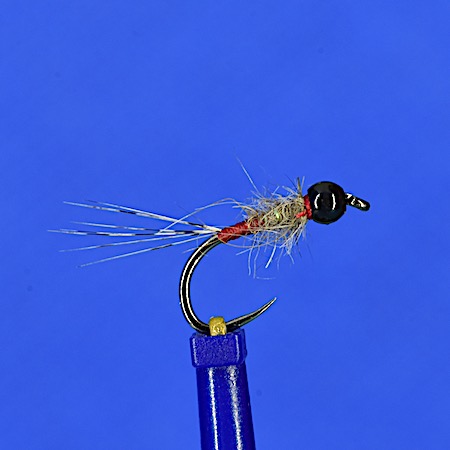
Iron Blue nymph
- HENDS BL455 (#14 & #16)
- Black 2.5 mm tungsten
- Red UNI-thread 8/0
- Coq De Leon tail
- Body rear – red floss
- Thorax – HENDS dubbing Code HZP02
Fishing the Iron Blue Nymph
It’s important to occasionally twitch the nymph when fishing the nymph in steady water to imitate its darting nature.
However, in steamy and turbulent water, the current provides enough motion to simulate the nymph’s darting movement.
The Dun stage
The Iron blue dun is a small fly (ca. 6mm), compared to other up-winged flies that hatch during April and May.
Both sexes of the IBD are similar in appearance, having a dark grey-olive body, dark grey-blue wings, and two tails. A notable exception is the colour of their eyes:
- Females have yellow eyes.
- Males have larger brown eyes

The fly will even hatch on cold wet days when nothing else is on the water. As such, provides some good dry fly fishing.
Hatches of Iron Blues occur in open water from late morning to around 5 pm in May & June. They often start as a little flurry, which sometimes can build into a dense cloud of emerging duns.
However, on the Welsh Dee and River Ribble, the hatches are usually a series of small flurries from mid-morning to late afternoon.
Fishing the Iron Blue Dun
Dry fly fishing
Dry fly fishing is my preferred method for catching trout feed Iron Blue Duns. Early in the season trout are not that fussy about your fly choice and you’re able to catch trout fishing a size 14 pattern.
My favourite early season Iron Blue fly pattern is:
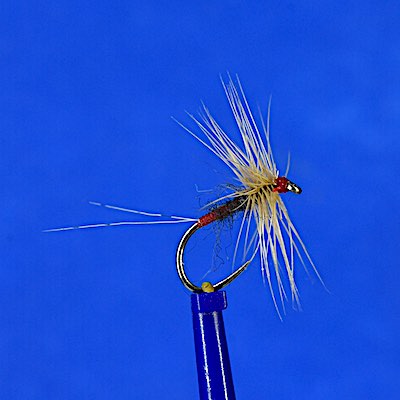
Iron Blue Dun
- HENDS BL455 (#14 to #18)
- Claret UNI-thread 8/0
- Tail – Coq De Leon
- Body – SLF Blue Dun
- Hackle – Medium Dun Cock
Also, a parachute version:
Iron Blue Parachute
- HENDS BL455 (#14 to #18)
- Claret UNI-thread 8/0
- Coq De Leon tail
- SLF Blue Dun body
- Cream Antron Yarmpost
- Medium Dun Cock hackle
As the season progresses trout become fussy and you will have to fish a smaller pattern i.e. #16 or #18 and sometimes a #20.
For wary trout, I find an emerger pattern fished in the surface film gives better results:
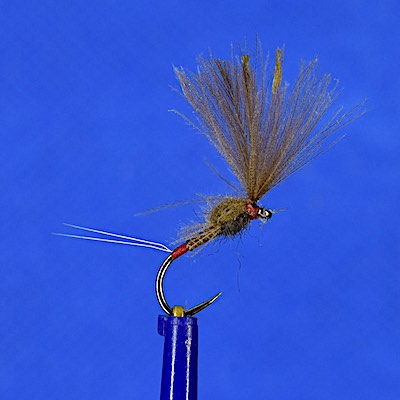
Iron Blue Dun Emerger
- HENDS BL455 (#14 to #18)
- Claret UNI-thread 8/0
- Tail – Coq De Leon
- Body – SLF Blue Dunb
- Wing – 3 CDC features
Wet fly fishing
There are times when trout and grayling are taking the emerging duns under the surface. When this happens, fishing an Iron Blue wet fly at the head and tail of the pool can produce some excellent results.
Over the years, I’ve tried several Iron Blue wet fly patterns but have always come back to the following pattern because it’s easy to tie and catches plenty of trout and grayling.
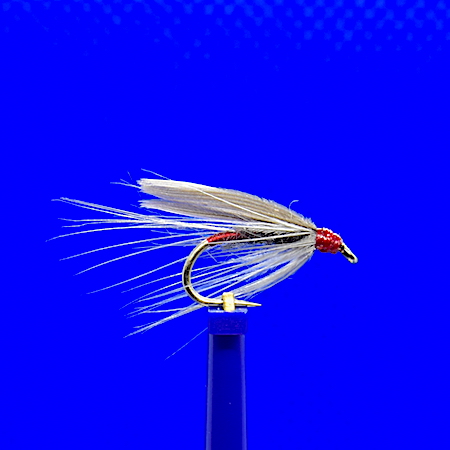
Iron Blue winged wet fly
- Kamasan B175 (#14 & #16)
- Claret UNI-thread 8/0
- Tail – Iron Blue Cock fibres
- Tag – Claret thread
- Body – Moles fur
- Hackle – Iron Blue hen
- Wing – Starling primary wing features
On northern UK rivers, it’s a successful winged-wet fly pattern for catching trout and grayling. As such, it’s one of my default wet flies when I don’t know what flies are going to hatch between May and September. Along with the March Brown Spider and Black Hopper, spaced 3ft apart on a 15ft leader.
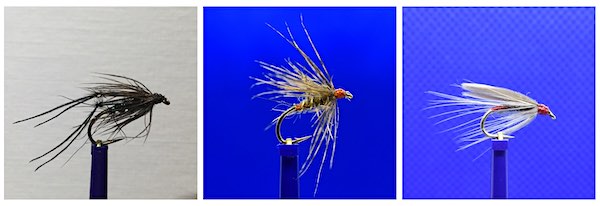
This wet fly team catches fish feeding on either olives, Iron Blue Dun, or terrestrials.
Spider fly fishing
If you are a fan of fishing traditional spider patterns, then Snipe & Purple (#16) and Dark Watchett (#16) are two excellent flies to use.
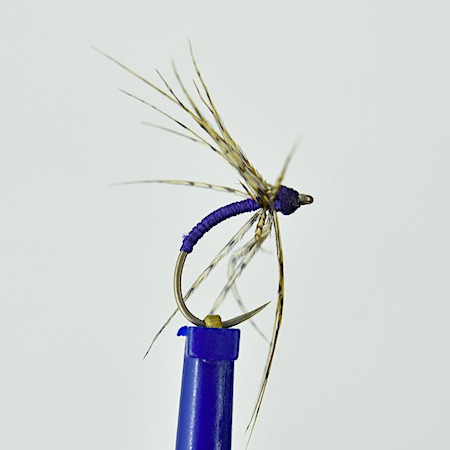
Snipe & Purple
- VARIVAS 2200BL (#16 & #18)
- Thread – Purple Silk
- Hackle – Grey pheasant neck
Recently, I have been having success fishing the following Iron Blue spider pattern that another angler suggested I try.
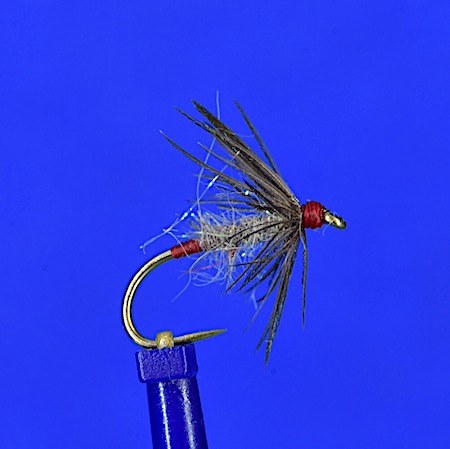
Iron Blue dun Spider
- Kamasan B175 (#14 & #16)
- Claret 8/0 Uni-Thread
- Body: HENDS dubbing Code HZP02
- Starling hackle
In addition, from the start of grayling fishing (16th in June), both these spiders are a great choice for catching grayling on the Welsh Dee.

The Iron Blue Spinner
After mating the female Iron Blue Spinner, identified by her red-brown body and clear wings, lays her eggs in the afternoon by dipping the tail of their abdomen into the river.
During the egg-laying stage, she will eventually get trapped in the surface film and be taken away by the current.
The male Iron Blue spinners are not that important to the fly fisherman because they generally drift away from the river after mating.
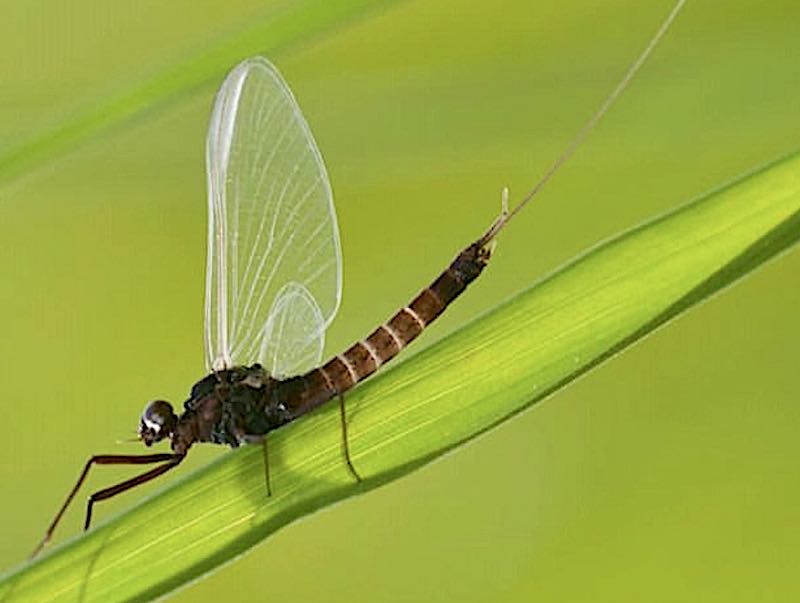
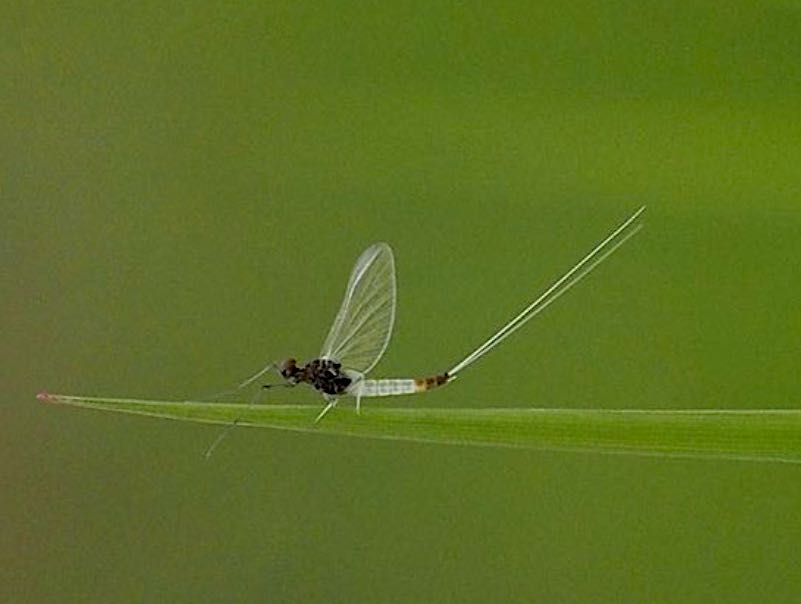
On the Welsh Dee and River Ribble, this usually occurs in the rocky riffle sections of pools pool. Below these sections is where trout and grayling take egg-laying spinners that have often got caught in the foam lines.
To target fish feeding on these dying spinners my preferred dry fly is the Claret Spinner (#16)
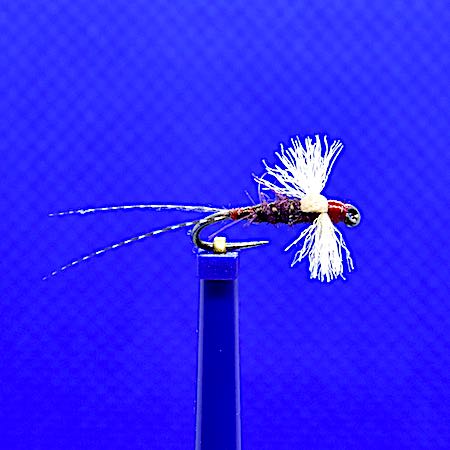
Claret Spinner
- HENDS BL354 #16
- Claret 8/0 UBI thread
- Tail – mallard
- Body – claret seals fur sub.
- Brown floss rib
- Cream Antron wing
- Wing case – 2mm beige foam
Additional fly patterns worth having in your fly box to imitate the spinner stage of the Iron Blue include Tups Indispensable (#16) or a Houghton Ruby (#16).
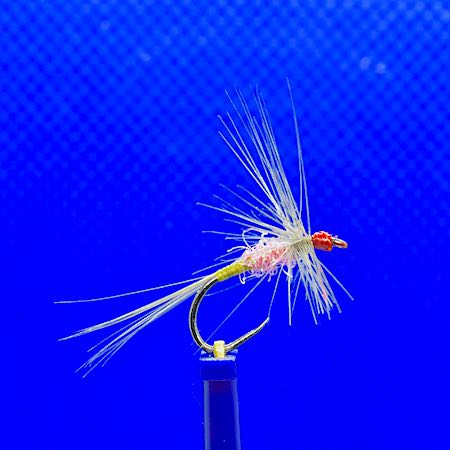
Tups Indispensable
- HENDS BL354 #16
- Yellow 8/0 UBI thread
- Tail – iron blue cock fibres
- Body – pink sparkle dubbing.
- Hackle – Iron blue cock
All of the flies discussed above catch trout and grayling on most UK rivers and definitely on the Welsh Dee at Llangollen, where I spend most of my time fishing. For more on fishing the Welsh Dee check out my digital fly fishing guides.
If you have enjoyed this article please share it with your fellow anglers.
Acknowledgements:
Johnny Auchenberg for the image of the female Iron Blue spinner
Liam Stenson for the image of the male Iron Blue Spinner
Rakkenes Fly Fishing & Fly Tying for the image of the Baetis Niger (M) – Southern Iron Blue Dun
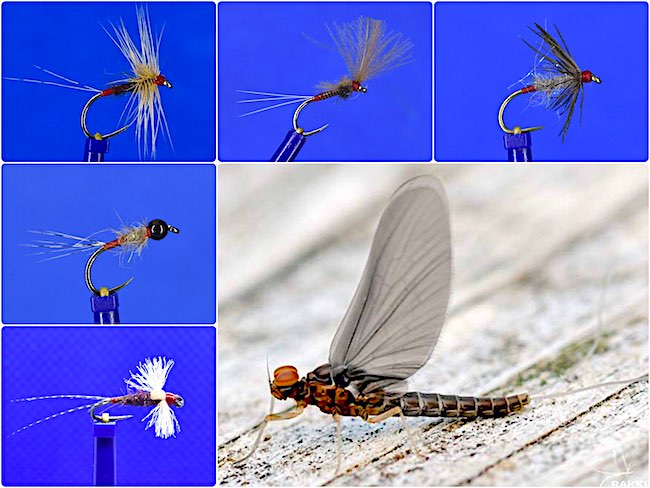
Great blog especially for a beginner like me. Thank you
Hi Tim,
I’m glad you are finding the blogs useful. This is the first in a series and the next featured fly is the Blue-winged Olive.
Cheers, Andrew
Very informative – I really like Andrew’s blog as there’s some great ideas to use
Hi Tim,
Thanks for the comments. Hopefully, the lockdown in Wales will ease and we will be able to get some sea trout fishing done in July at Llangollen.
Cheers, Andrew
Hi, yep fishing on the Dee at Llangollen has been tough given the bright and warm conditions. Fish are about, but you have to seek them out. Plenty of risers late evening 8.30pm onwards. Hope to see you back on the water soon..
Hi David, it’s good to see that you have been managing to get out fishing on the Welsh Dee and catch a few trout in the evening. It’s difficult to express how much I’m missing fishing at Llangollen. I do hope things improve soon so I can have a trip out, before you catch all the fish 🙂
Great read thanks !
Hi Lee,
It’s great to hear you enjoyed the post.
Cheers, Andrew
Very informative as always Andrew.
Hi Steve,
Pleased to hear that you found the post interesting.
Cheers, Andrew
Hi Andrew being a novice to rivers i look forward to your posts. Keep them comin
Thanks again
Paul
Hi Paul,
Good to hear the posts are helping you. Planning on writing a few more, which should also be heplful.
Thanks for the feedback, Andrew
Another great blog Andrew, very impressed with your tying.
Tanks
Cheers
Top class read, Thank You.
Cheers
Andrew,
I throughly enjoy your blog and the info you provide us on the various flies and how to tie them.
Joe Kurry
US
Hi Joe,
It’s great to hear you enjoyed the post.
Cheers, Andrew
Brilliant stuff. Your blogs are so interesting and helpful. Love them ! thanks 🙂
Cheers
Interesting article and the flies are very nice.
Thank you for sharing about your waters.
Hi Micheal,
Good to hear you enjoyed the post.
Tight lines, Andrew
Thank you very much for your blog. I am a great fan!!! Clear, concise, speaking of nowadays patterns as well as the légende ones…i am always impatiently for the next article!!!
Pascal from France
Thanks for the useful feedback
As always a great and informative article with easy instructions on tying all the patterns which I hope will catch when I fish the Dee in July at the EPFFA Internationals As always many thanks for the time you take to help all you readers and followers..
Cheers
Great info ,absolutely invaluable for a beginner like myself,fishing the dee at llangollen begining July,going to try some of your suggestions,thankyou
Roy
Hi Roy,
Pleased to hear you found the post interesting and helpful.
Thanks for the feedback, Andrew
Such valuable pointers to help identify the likely target insect at the right time of year, how to tie them in the appropriate size and how to best fish them. Thanks Andrew. Terrific articles on North Country Spiders too.
Great to hear. Tight lines, Andrew
Excellent article- really useful information
Hi David,
Great to hear you found it.
Tight line, Andrew
Always a pleasure to read your articles Andrew and thankyou for imparting your knowledge and experience to everyone. Hopefully this prolonged spell of north east winds and high temperatures will change one day. Well thats what we are experiencing in Essex. Tight lines my friend.
Hi Ian,
Thanks for the great comments. We do need a change in the weather to freshen the rivers and the fishing up.
Tight lines, Andrew